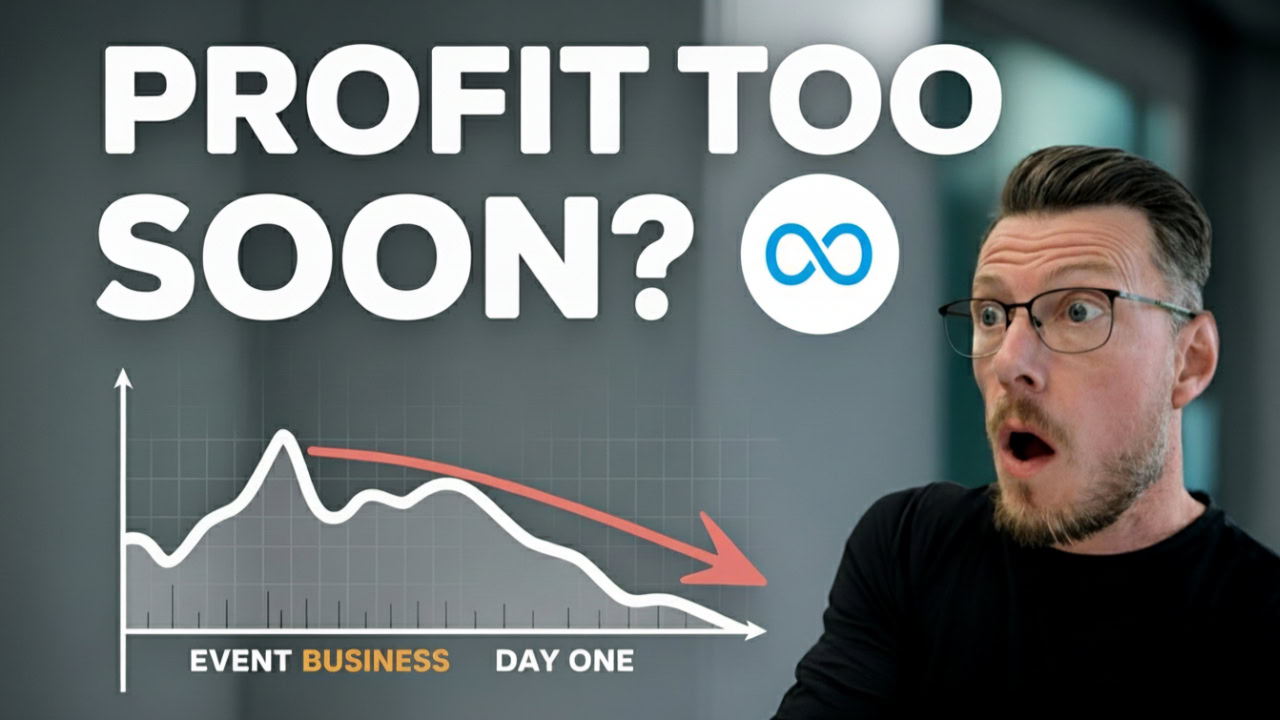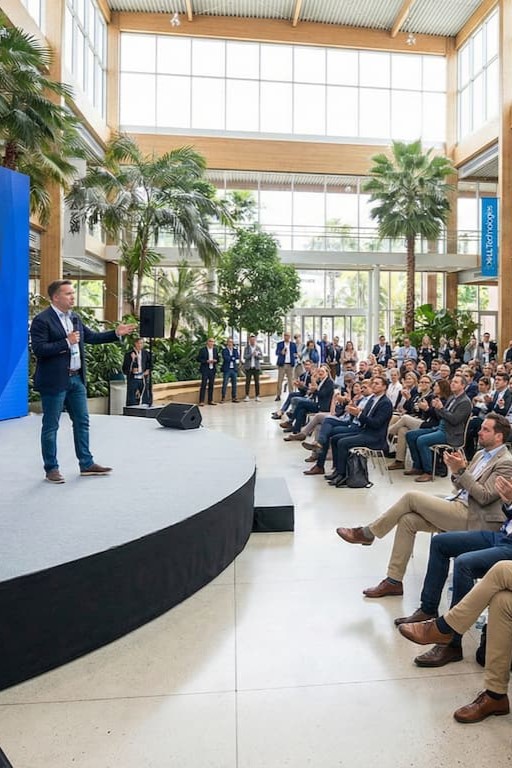Dan Charles
10/10/2025
Table of Contents

Most event agencies are trapped in a devastating cycle: they plan events 6-12 months in advance but concentrate all marketing efforts in the final 3-4 weeks before each event. This backwards approach creates the very cash flow problems that 82% of businesses cite as their primary reason for failure.
The solution isn’t more marketing – it’s strategic timeline planning that addresses the 4-6 month lag between marketing action and business results. This comprehensive framework will transform your approach from reactive panic to predictable revenue generation.
Key Takeaways
- The 4-Phase System eliminates the feast-or-famine cycle by building evergreen marketing foundations with seasonal campaign overlays
- Phase timing is critical – marketing activities must lead event dates by 4-6 months to account for B2B decision-making timelines
- Data overlay analysis combining your historical patterns with industry trends reveals hidden inflection points that enable predictive planning
- Evergreen content addressing year-round pain points generates more consistent leads than seasonal campaigns focused on individual events
- Implementation requires systematic change – most agencies need 90 days to fully transition from reactive to predictive marketing approaches
Understanding the Marketing-Revenue Lag Effect
Before diving into the framework, you must understand why traditional event marketing timelines fail. Industry research from Lyyti and DataBusiness confirms that while event professionals spend 6-12 months planning major corporate events, marketing activities are concentrated in just 3-4 weeks before the event date.
This creates a devastating timeline mismatch:
B2B Event Decision Timeline:
- Months 1-2: Problem recognition and initial research
- Months 3-4: Vendor evaluation and proposal requests
- Months 5-6: Budget approval and final decision making
Traditional Marketing Timeline:
- Months 1-5: No marketing activity (too busy with current events)
- Month 6: Panic marketing begins 3-4 weeks before event
By the time most agencies start marketing, their ideal customers have already made their decisions. The result? Predictable quiet periods that follow busy seasons, creating the cash flow challenges that plague the industry.
The 4-Phase Event Marketing Timeline System
This proven framework addresses the timeline mismatch by building evergreen marketing systems that work consistently, then layering seasonal campaigns over this foundation.
Phase 1: Foundation Building (Months 1-3)
Create the Evergreen Marketing Infrastructure
Step 1: Identify Year-Round Customer Pain Points
Your customers face consistent challenges regardless of season. These permanent pain points should drive your evergreen marketing, not individual event promotion.
Primary Pain Points for Event Buyers:
- Budget planning and allocation stress
- Vendor coordination and management complexity
- Timeline development and project management challenges
- ROI measurement and reporting requirements
- Compliance and risk management concerns
- Staff capacity and resource allocation issues
Action Items:
- Survey past clients about their ongoing challenges
- Analyze support tickets and consultation requests for common themes
- Interview prospects about problems they face year-round, not just during events
- Map pain points to specific content opportunities
Step 2: Develop Evergreen Content Systems
Create content that addresses permanent pain points through multiple formats and channels.
Content Types That Work Year-Round:
- Educational blog posts addressing ongoing challenges
- Video tutorials for common processes and decisions
- Downloadable resources and planning templates
- Email nurture sequences for different buyer journey stages
- Social media thought leadership on industry trends
Content Calendar Structure:
- 60% evergreen content addressing permanent pain points
- 30% seasonal content aligned with industry cycles
- 10% reactive content responding to immediate opportunities
Step 3: Build Automated Lead Generation Infrastructure
Implement systems that capture and nurture leads consistently, regardless of your availability to manually manage campaigns.
Essential Automation Components:
- SEO-optimized landing pages for year-round search terms
- Lead magnets solving specific customer pain points
- Email automation sequences for different customer segments
- Social media scheduling and engagement systems
- CRM integration for lead scoring and qualification
Phase 2: System Activation (Months 4-6)
Launch and Optimize Evergreen Systems
Step 4: Data Tracking and Correlation Analysis
Establish systems to track the relationship between marketing activities and business outcomes across extended timeframes.
Critical Metrics to Track:
- Lead generation velocity by source and season
- Time from first contact to qualified opportunity
- Average deal size and customer lifetime value trends
- Seasonal demand patterns vs. evergreen baseline performance
- Cost per acquisition across different timeline approaches
The Data Overlay Method:
- Map your revenue patterns over the last 2-3 years
- Identify peaks, valleys, and transition periods
- Layer industry demand data over your historical patterns
- Identify inflection points where marketing gaps created revenue problems
- Project forward to predict and prevent future quiet periods
Step 5: Evergreen Campaign Launch
Begin consistent, year-round marketing addressing permanent customer pain points.
Launch Sequence:
- Week 1: Activate SEO-optimized content publishing schedule
- Week 2: Launch lead generation campaigns for evergreen topics
- Week 3: Begin email nurture sequences for captured leads
- Week 4: Establish social media thought leadership presence
Step 6: Performance Monitoring and Initial Optimization
Track performance against baseline metrics and make initial adjustments based on early results.
Key Performance Indicators:
- Lead generation consistency vs. historical patterns
- Content engagement rates by topic and format
- Email nurture sequence progression and conversion rates
- Social media audience growth and engagement quality
Phase 3: Seasonal Integration (Months 7-9)
Layer Seasonal Campaigns Over Evergreen Foundation
Step 7: Strategic Seasonal Campaign Planning
Design event-specific campaigns that build upon your evergreen foundation rather than replacing it.
Seasonal Campaign Strategy:
- Maintain evergreen content as the baseline (never stop)
- Add seasonal content that references and builds upon evergreen themes
- Create event-specific lead magnets and landing pages
- Develop targeted advertising campaigns for seasonal keywords
- Establish partnership and collaboration opportunities for peak periods
Timeline Coordination:
- Begin seasonal campaigns 6 months before target events
- Use evergreen systems to shorten the path from awareness to booking
- Leverage existing relationships built through year-round value delivery
Step 8: Integrated Campaign Execution
Execute seasonal campaigns while maintaining evergreen system performance.
Execution Framework:
- 70% capacity devoted to evergreen system maintenance
- 30% capacity allocated to seasonal campaign optimization
- Weekly performance reviews comparing seasonal lift against evergreen baseline
- Real-time adjustments based on campaign performance data
Step 9: Peak Period Management
Maintain marketing momentum during your busiest periods when most agencies stop all marketing activity.
Busy Season Strategy:
- Reduce marketing intensity but never stop completely
- Focus on highest-ROI activities during capacity constraints
- Use automation to maintain consistent touchpoints
- Plan post-peak marketing acceleration to prevent revenue valleys
Phase 4: Optimization and Scaling (Months 10-12)
Analyze, Refine, and Prepare for Growth
Step 10: Comprehensive Performance Analysis
Analyze the full year’s data to identify patterns, optimize performance, and plan for scaling.
Analysis Framework:
- Compare evergreen performance vs. seasonal campaign results
- Identify highest-ROI content types and distribution channels
- Map customer journey optimization opportunities
- Calculate true customer acquisition costs across different timeline approaches
- Project revenue predictability improvements and cash flow stabilization
Step 11: System Refinement and Optimization
Use insights to eliminate ineffective tactics and amplify successful approaches.
Optimization Priorities:
- Double down on highest-performing evergreen content themes
- Eliminate or redesign underperforming seasonal campaigns
- Streamline automation systems for better efficiency
- Expand successful approaches to new channels or markets
Step 12: Scaling Preparation
Prepare systems and processes for increased demand and expanded operations.
Scaling Readiness Checklist:
- Automation systems capable of handling 3x current volume
- Content production processes that maintain quality at scale
- Team capacity planning for increased lead volume
- Financial systems ready for more predictable, higher revenue streams
Advanced Implementation Strategies
The Premier Partnership Advantage
Access to industry data through premier partnerships with Google Ads and Meta provides insights that individual businesses can’t obtain independently. This aggregate intelligence reveals:
- Supply and demand patterns across the entire event industry
- Seasonal trend forecasting 6-12 months ahead
- Search behavior shifts before they become obvious to individual businesses
- Geographic opportunity mapping and competitive landscape evolution
How to Leverage Industry Data:
- Combine your historical performance data with industry trends
- Identify opportunities where market demand exceeds current supply
- Predict seasonal shifts before competitors recognize them
- Adjust timeline planning based on broader market intelligence
Handling Mindset Resistance
The biggest challenge in implementing strategic timeline planning isn’t tactical – it’s mindset resistance to thinking beyond immediate needs.
Common Resistance Patterns:
- “We’re too busy during peak season to think about marketing”
- “Our clients make decisions much faster than 4-6 months”
- “Evergreen content doesn’t feel relevant to our seasonal business”
- “We’ve always done fine with word-of-mouth referrals”
Overcoming Resistance Through Data:
- Map client historical pain points and revenue patterns
- Overlay industry trend data showing broader patterns
- Demonstrate correlation between marketing gaps and revenue valleys
- Project forward showing predictable impact of strategic timeline planning
Research shows that post-pandemic cash flow unpredictability has been exacerbated across the event sector, making strategic timeline planning more critical than ever for business survival.
Common Implementation Mistakes and Solutions
Mistake 1: Starting Seasonal Campaigns Too Late
Problem: Beginning seasonal campaigns 6-8 weeks before events, missing the 4-6 month B2B decision timeline.
Solution: Map your ideal customer’s decision-making process and begin seasonal campaigns at the moment they start recognizing they’ll need your services, typically 6+ months before event dates.
Mistake 2: Stopping Evergreen Systems During Busy Periods
Problem: Abandoning consistent marketing during peak periods, creating predictable revenue valleys.
Solution: Reduce marketing intensity during busy periods but never stop completely. Use automation to maintain minimum viable marketing momentum.
Mistake 3: Focusing Only on New Customer Acquisition
Problem: Neglecting existing customer nurturing and expansion opportunities.
Solution: Allocate 40% of timeline planning to existing customer growth opportunities, which typically provide faster ROI and higher lifetime value.
Mistake 4: Ignoring Corporate Budget Cycles
Problem: Planning marketing timelines around event dates rather than customer budget decision cycles.
Solution: Align major campaigns with corporate budget planning periods (typically Q4 for following year) rather than just event seasons.
Measuring Timeline Planning Success
Success requires tracking metrics that reveal long-term patterns rather than short-term fluctuations.
Leading Indicators (Predict Future Performance)
- Content engagement rates by customer segment and topic
- Lead generation velocity and quality score trends
- Email nurture sequence progression and engagement rates
- Social media audience growth rate and engagement quality
Lagging Indicators (Confirm Results)
- Revenue predictability and variance reduction over time
- Customer acquisition cost trends across different timeline approaches
- Average deal size and customer lifetime value improvements
- Sales cycle length reduction and conversion rate optimization
Correlation Metrics (Prove Timeline Impact)
- Marketing activity to revenue correlation by time period
- Seasonal campaign performance vs. evergreen baseline
- Timeline planning accuracy vs. actual business results
- Cash flow predictability improvement year over year
Your 90-Day Implementation Roadmap
Days 1-30: Foundation Phase Assessment and Planning
Week 1: Current State Analysis
- Map your historical revenue patterns and identify seasonal challenges
- Analyze past marketing activities and their correlation to business results
- Survey clients about year-round pain points vs. seasonal needs
Week 2: Pain Point Research and Content Planning
- Interview prospects about ongoing challenges they face
- Identify the top 3-5 evergreen pain points to address
- Plan content calendar addressing permanent customer problems
Week 3: System Architecture and Tool Selection
- Choose automation platforms for lead capture and nurturing
- Set up tracking systems for timeline correlation analysis
- Design lead magnets addressing identified pain points
Week 4: Content Creation and System Building
- Develop first month of evergreen content
- Build lead capture systems and email automation sequences
- Create measurement dashboards for performance tracking
Days 31-60: System Activation and Initial Optimization
Week 5-6: Evergreen System Launch
- Publish first evergreen content pieces and lead magnets
- Launch email automation sequences for captured leads
- Begin consistent social media thought leadership presence
Week 7-8: Performance Monitoring and Adjustment
- Track initial performance against baseline metrics
- Optimize underperforming content and automation sequences
- Gather feedback from early leads and adjust messaging
Days 61-90: Seasonal Integration and Scaling Preparation
Week 9-10: Seasonal Campaign Planning
- Plan seasonal campaigns for 6 months ahead using evergreen foundation
- Design integrated campaigns that build upon evergreen themes
- Set up tracking for seasonal performance vs. evergreen baseline
Week 11-12: Integration and Future Planning
- Launch first integrated seasonal campaigns over evergreen foundation
- Analyze 90-day performance and plan for continued optimization
- Prepare systems for scaling based on improved lead generation
Beyond Timeline Planning: Building Complete Marketing Systems
Timeline planning is just the foundation of building predictable event marketing systems. The most successful agencies combine strategic timeline planning with comprehensive lead generation systems, automated nurturing processes, and performance optimization frameworks.
This integrated approach transforms timeline planning from a scheduling exercise into a complete business transformation system that generates consistent results regardless of seasonal fluctuations.
Ready to implement the 4-Phase Event Marketing Timeline System in your business? Book an Evergreen Event Profit System Strategy Assessment to analyze your current timeline approach, identify optimization opportunities, and create a customized 90-day implementation plan.
During this comprehensive assessment, we’ll map your historical patterns, overlay industry intelligence, and design a timeline system specifically calibrated for your business type and market opportunities. You’ll leave with a clear roadmap for transforming your marketing from reactive panic to predictable revenue generation.
The event businesses implementing strategic timeline planning today will capture the majority of market share tomorrow. The question isn’t whether this system works – it’s whether you’ll implement it before your competitors do.

Why Your Event Business Doesn’t Need More Martech: It Needs a Coherent Message

Universal Attribution for Event Businesses: Track Every Lead Across Any Form Tool

The 4-Phase Event Marketing Timeline System: From Reactive Panic to Predictable Revenue




